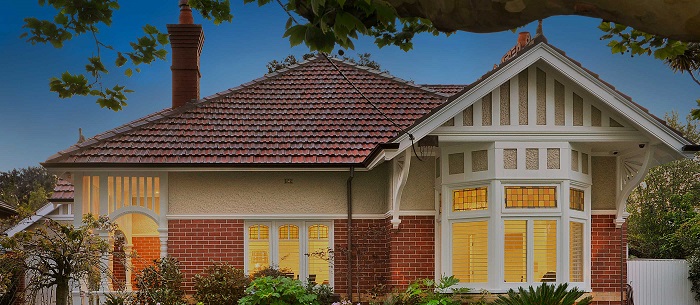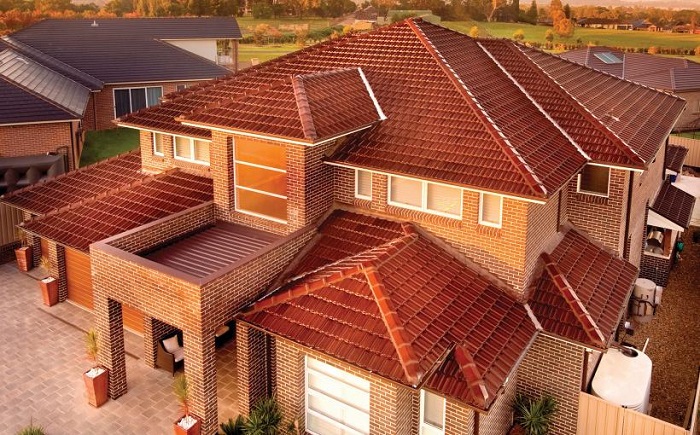The use of terracotta in sculpture, pottery and architecture goes back several millennia. Terracotta, Italian for ‘baked earth’, is made from a type of coarse porous clay, which is shaped and then fired in a kiln at high temperature until it vitrifies to create a hard, waterproof surface and takes on its characteristic red-brown-orange hue. Right from Palaeolithic times to the modern day, terracotta has been an integral part of everyday life, be it in the form of figurines, statues and decorative art to the more mundane pots and pans or as a building material to create artistic facades as well as bricks and tiles.
History
Terracotta roof tiles were used in China as early as 10,000 BC as well as the Middle East from where the use of clay roof tiles spread to many parts of the world, especially Asia and Europe. Coloured and glazed tiles came into vogue in the 18th century and became popular not only for their visual appeal but also their fire retardant properties. The Italian Renaissance Revival period in the late 19th century saw the spotlight return to terracotta roof tiles with architects taking inspiration from Italian villa-style designs.
Early terracotta tiles were mostly flat and rectangular in shape with peg holes at one end to anchor them to the roof. Interlocking S-shaped pan or Flemish tiles were also popular in the 18th century.
Outdoor terracotta tiles
Terracotta is a durable material as evidenced by the number of artefacts from ancient times unearthed over the centuries. Made from abundantly available natural clay, terracotta roof tiles contribute to the energy efficiency of the home, while their fire-proof qualities keep the building safe, especially in bushfire regions. When properly maintained, terracotta tiles have a long lifespan exceeding 70 years, and are also recyclable, adding to the material’s outstanding green credentials.
Terracotta has excellent insulation qualities with its high thermal mass making the material ideal for Australia’s extreme climate. Being waterproof, terracotta tiles prevent leaky roofs. The heavy weight is a real advantage as there is less likelihood of the tiles being blown away in strong wind conditions. Clay roof tiles make for a practical choice in coastal constructions as there is no risk of corrosion or rusting from exposure to the marine environment. The acoustic performance of terracotta roof tiles helps reduce external noise to create a comfortable interior space.
Terracotta’s timeless appeal is a major drawcard when it comes to selecting a roof tile. The upmarket look it lends to a home has a positive impact on market value. Both handcrafted and machine made roof tiles are available to meet heritage and contemporary architecture styles. Terracotta roof tile patterns include Mission Style, French Style, Interlocking Shingle Style, and Spanish Style. An interlocking profile helps keep the tiles in place, especially on steeply pitched roofs.
In Australia, terracotta roof tiles have been a common, yet timeless feature on Federation-style, California Bungalow-style, Old English-style and Spanish Mission-style homes, adding elegance, colour and character to the roofscape.
Types of terracotta roof tiles
Plain terracotta tiles are quite common and come in a square or rectangular shape. These roof tiles are typically used on traditional Mediterranean-style houses.
Peg roof tiles feature holes on one end for simple fixing by roofers. Peg tiles are typically used during repair or replacement of roof tiles.
Ornamental tiles have a small decorative detail at the bottom and are installed purely for aesthetics.
Camber terracotta roof tiles feature an arch, which lends a wave-like effect to the roof. Single tiles have one arch while double tiles have two smaller arches.
Terracotta roof tiles are available in unglazed and glazed finishes. Glazed tiles add waterproof qualities to the roof as well as elegant looks with a choice of colours, styles and textures.
Colours
Traditionally, terracotta tiles feature a red-brown-orange tone, which comes from iron particles in the clay reacting with oxygen. This reddish colour is moderately reflective and meets cool roof requirements. However, with the focus turning to sustainable building and energy efficiency, terracotta roof tiles are being manufactured with higher reflectance and emissivity using different colours including red, brown, grey, blue and green.
Disadvantages
The heavy weight of terracotta roof tiles can be a disadvantage during installation. Only correct installation will ensure that the roof stands up to bad weather or extreme climate. Terracotta tiles are also susceptible to cracks and breaks on impact, be it from hard knocks or walking on them. Clay tiles are not recommended for low pitch roofs as they can potentially impede drainage.
Maintenance and restoration
Maintaining a terracotta tile roof is not a difficult task and the material is tough enough to withstand extreme weather. However, regular maintenance is advised because terracotta roof tiles are susceptible to moss, lichen and mould besides accumulation of dirt over time.
A typical restoration process involves inspection and repair, followed by deep cleaning using a high pressure water blaster to remove dirt, moss and mould. Once the roof is cleaned, it is coated with a special protective terracotta glaze that strengthens the tiles.
Terracotta Roof Replacement- Concrete tiles
Terracotta tiles Vs Concrete tiles
While terracotta and concrete roof tiles are quite similar in appearance, there are major differences between the two tile options in terms of weather performance, function, physical qualities, lifespan, and price.
Terracotta roof tiles are lighter than concrete roof tiles by at least 40 per cent, enabling easier installation, especially on lighter roof structures. Terracotta tiles keep the home comfortable throughout the year. Concrete tiles absorb more moisture, leading to algae and mildew growth, which can increase maintenance costs. Terracotta tiles have a longer life compared to concrete roof tiles, which can last for a maximum of 50 years. However, terracotta tiles are also pricier, typically costing $80-$110 per square metre.
Terracotta tiles can also be used for the floor.
Top 3 terracotta roof tiles in Australia avaibale from Bunnings
Monier Roofing
Overview
Handcrafted in Australia, Monier’s terracotta tile range brings home the timelessness and beauty of the material. Available in a choice of four profiles – Marseille, Nouveau, Nullarbor and Urban Shingle – Monier’s terracotta roof tiles come in an extensive colour palette including metallic finishes. Monier terracotta roof tiles have a 50-year warranty.
Colours
Titan Gloss, Peak, Mystic Grey, Comet, Pottery Brown, Bedrock, Delta Sands, Riverstone, Earth, Mars, Aurora, Bungalow, Tanbark, Sunset, Cottage Red, Florence Red, Burgundy, Ravine

Monier Marseille terracotta roof tiles
Boral Roofing
Overview
Manufactured in Australia, Boral’s terracotta roof tile range includes French, featuring a shaped profile to suit classic architectural styles, and Swiss, which is based on a bold European design and features clean lines to fit modern and Mediterranean style homes. All Boral terracotta roof tiles come with a 50-year guarantee.
Price
$4.99 per tile (NSW)
Colours
Antique Bronze, Sydney Red, Sienna Red, Jaffa Red, Autumn Leaf, Federation, Crimson Blaze, Burgundy, Mahogany, Wild Chocolate, Feldspar, Ghost Gum, Slate Grey, Eclipse, Ebony
Buy
https://www.boraldirect.com.au/terracotta

Boral French terracotta roof tiles
Bristile Roofing
Overview
La Escandella European terracotta roof tiles by Bristile Roofing are made in a state-of-the-art facility in Spain. Ranging from European style high roll tiles to flat contemporary options, Bristile’s terracotta roof tile collection complements a broad range of house designs. The profiles include Curvado, Innova, Marseille, Medio Curva, Planum, Vienna and Visum. All terracotta roof tiles are offered with a Colour for Life Warranty, as well as a 50 or 100 Year Product Warranty depending on the range.
Colours
Baltic, Caviar, Cocoa, Slate, Turron, Wallaroo, Burnt Ochre, Granite, Jaspee Roja, Roja, Truffle, Amber Haze, Grey Vermont, Old England, Russet, Idella Grey, Blackstone, Pepper, Aitana, Cartago, Galia, Hispania, Lucentum, Marron, Milenium, Tossal etc.

Terracotta roof tiles – Vienna profile

